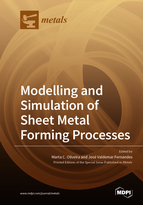Modelling and Simulation of Sheet Metal Forming Processes
A special issue of Metals (ISSN 2075-4701). This special issue belongs to the section "Metal Casting, Forming and Heat Treatment".
Deadline for manuscript submissions: closed (31 August 2019) | Viewed by 63269
Special Issue Editors
Interests: applied and computational mechanics; sheet metal forming processes; numerical simulation; constitutive modelling; contact with friction problems; optimization techniques and algorithms
Interests: large plastic deformations; inverse analysis; applications to metal forming; material parameters identification; modeling and mechanical behaviour of carbon nanotubes
Special Issues, Collections and Topics in MDPI journals
Special Issue Information
Dear Colleagues,
In the mid-1970s, B. Budiansky expressed his dream: “I imagined a black box—a black computation box that was incredibly powerful and into which we could feed a mathematical description of what the stylists envisioned for a certain sheet metal shape. Then push a button and the computer spits out the die shape, the blank configuration needed, the draw beads and their orientation and configuration. If it is not possible, it tells us that too! […]. Even if it is possible, perhaps that's not enough information, and so the computer will give us the probability of success, if we have fed in variabilities in thicknesses, moduli, shapes of stress-strain relations, and so on.” (in: Mechanics of Sheet Metal—Material Behavior and Deformation Analysis, Koistinen and Wang , Eds., Plenum Press, 1978).
This challenge involves continuous developments in different areas, such as: (i) constitutive modelling, including hardening, anisotropy and damage; (ii) friction modelling; (iii) failure criteria; (iv) strategies for parameters identification of constitutive, friction and failure models; (v) numerical models for description of the contact with friction conditions, including deformable tools; (vi) numerical strategies for the analysis of multistep sheet metal forming processes; (vii) optimization procedures combined with numerical simulation, to define forming process parameters; (viii) numerical simulation combined with statistical analysis tools; and (ix) application to novel sheet metal forming processes and materials, such as warm forming and multi-layer sheets.
The aim of this Special Issue is to collect full papers, communications and reviews, about modeling and numerical simulation of sheet metal forming processes, which may contribute to bridge the gap between dream and virtual reality.
Prof. Marta OliveiraProf. José Valdemar Fernandes
Guest Editors
Manuscript Submission Information
Manuscripts should be submitted online at www.mdpi.com by registering and logging in to this website. Once you are registered, click here to go to the submission form. Manuscripts can be submitted until the deadline. All submissions that pass pre-check are peer-reviewed. Accepted papers will be published continuously in the journal (as soon as accepted) and will be listed together on the special issue website. Research articles, review articles as well as short communications are invited. For planned papers, a title and short abstract (about 100 words) can be sent to the Editorial Office for announcement on this website.
Submitted manuscripts should not have been published previously, nor be under consideration for publication elsewhere (except conference proceedings papers). All manuscripts are thoroughly refereed through a single-blind peer-review process. A guide for authors and other relevant information for submission of manuscripts is available on the Instructions for Authors page. Metals is an international peer-reviewed open access monthly journal published by MDPI.
Please visit the Instructions for Authors page before submitting a manuscript. The Article Processing Charge (APC) for publication in this open access journal is 2600 CHF (Swiss Francs). Submitted papers should be well formatted and use good English. Authors may use MDPI's English editing service prior to publication or during author revisions.
Keywords
- Numerical simulation
- Modeling
- Hardening
- Anisotropy
- Parameters identification
- Inverse analysis
- Damage
- Mechanical properties
- Application to sheet metal forming







